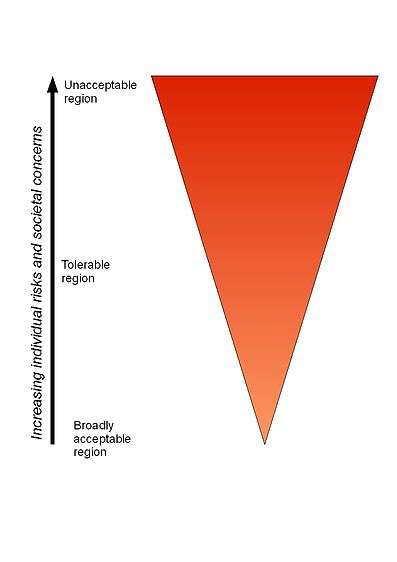ALARP
ALARP stands for "as low as reasonably practicable", and is a term often used in the regulation and management of safety-critical and safety-involved systems.[1][2] The ALARP principle is that the residual risk shall be reduced as far as reasonably practicable. In UK and NZ Health and Safety law, it is equivalent to SFAIRP (So Far As Is Reasonably Practicable). ALARA (As Low As Reasonably Achievable) is a similar term used in USA.
For a risk to be ALARP, it must be possible to demonstrate that the cost involved in reducing the risk further would be grossly disproportionate to the benefit gained.[3] The ALARP principle arises from the fact that infinite time, effort and money could be spent in the attempt of reducing a risk to zero. It should not be understood as simply a quantitative measure of benefit against detriment. It is more a best common practice of judgement of the balance of risk and societal benefit.
Factors
In this context, risk is the combination of the frequency (likelihood) and the consequence of a specified hazardous event.
The following factors are likely to be considered when deciding whether or not a risk has been reduced as far as reasonably practical.[3][4]
- Health and safety guidelines and codes of practice
- Manufacturer's specifications and recommendations
- Industry practice
- International standards and laws
- Suggestions from advisory bodies
- Comparison with similar hazardous events in other industries
- Cost of further measures would be disproportionate to the risk reduction they would achieve
Another factor that often comes into the ALARP principle, is the cost of assessing the improvement gained in an attempted risk reduction. In extremely complex systems, this can be very high, and could be the limiting factor in practicability of risk reduction, although according to HSE guidance, cost alone should never be a justification for taking extra safety risks.
Determining that a risk has been reduced to ALARP involves an assessment of the risk to be avoided, of the sacrifice (in money, time and trouble) involved in taking measures to avoid that risk, and a comparison of the two. This is a cost–benefit analysis.
Origin in UK law
The term ALARP arises from UK legislation, particularly the Health and Safety at Work etc. Act 1974, which requires "Provision and maintenance of plant and systems of work that are, so far as is reasonably practicable, safe and without risks to health". The phrase So Far As is Reasonably Practicable (SFARP) in this and similar clauses is interpreted as leading to a requirement that risks must be reduced to a level that is As Low As is Reasonably Practicable(ALARP).
The key question in determining whether a risk is ALARP is the definition of reasonably practicable. This term has been enshrined in the UK case law since the case of Edwards v. National Coal Board in 1949. The ruling was that the risk must be significant in relation to the sacrifice (in terms of money, time or trouble) required to avert it: risks must be averted unless there is a gross disproportion between the costs and benefits of doing so.[5]
Including gross disproportion means that an ALARP judgement in the UK is not a simple cost benefit analysis, but is weighted to favour carrying out the safety improvement. However, there is no broad consensus on the precise factor that would be appropriate.
Use outside the UK
Outside the UK the ALARP principle is often not used; instead standards and 'good engineering practice' are adhered to, and legislation tends to require absolute levels of safety.
The term ALARA, or "as low as reasonably achievable" is used interchangeably in the United States of America, almost exclusively in the field of radiation protection.
Where the ALARP principle is used, it may not have the same implications as in the UK, as "reasonably practicable" may be interpreted according to the local culture, without introducing the concept of gross disproportionality.
Legal challenge
A two-year legal battle in the European Court of Justice resulted in the SFAIRP principle being upheld on 18 January 2007.
The European Commission had claimed that the SFAIRP wording in the Health & Safety at Work Act did not fully implement the requirements of the Framework Directive. The Directive gives employers an absolute duty "to ensure the safety and health of workers in every aspect related to the work", whereas the Act qualifies the duty "So Far As is Reasonably Practicable". The court dismissed the action and ordered the Commission to pay the UK's costs.[6][7]
Had the case been upheld, it would have called into question the proportionate approach to safety risk management embodied in the ALARP principle.
Carrot diagrams

They can be used to map risks, by indicating high (normally unacceptable) risks at the upper/wider end and low (broadly acceptable) risks at the lower/narrower end. The region in between is sometimes called the ALARP region. However, this is misleading because ALARP refers to the principle of testing further risk reduction against the cost of this reduction effort, regardless of tolerability, and applies to all regions. A better name is the 'tolerable region', because risks in this region can sometimes be tolerated, if it can be shown that reasonable mitigations have been put in place.
See also
References
- ↑ "ALARP Guidance Note" (PDF). Commonwealth Offshore Petroleum and Greenhouse Gas Storage (Safety) Regulations 2009. NOPSEMA. June 2015.
- ↑ "ALARP Guidance". UK Health and Safety Executive.
- 1 2 "Reasonably Practical" (PDF). WorkSafe New Zealand. March 2016.
- ↑ "The Meaning of Reasonably Practicable" (PDF). Safe Work Australia. 2011.
- ↑ Edwards v. National Coal Board. (1949) All ER 743 (CA)
- ↑ Judgement of the Court on Case C-127/05
- ↑ Press release Archived 3 December 2008 at the Wayback Machine. by the UK Health and Safety Executive
External links
- UK Health and Safety Executive ALARP Guidance
- UK Health and Safety Executive ALARP Cost Benefit Analysis
- UK Defence Standard 00-56 Safety Management Requirements